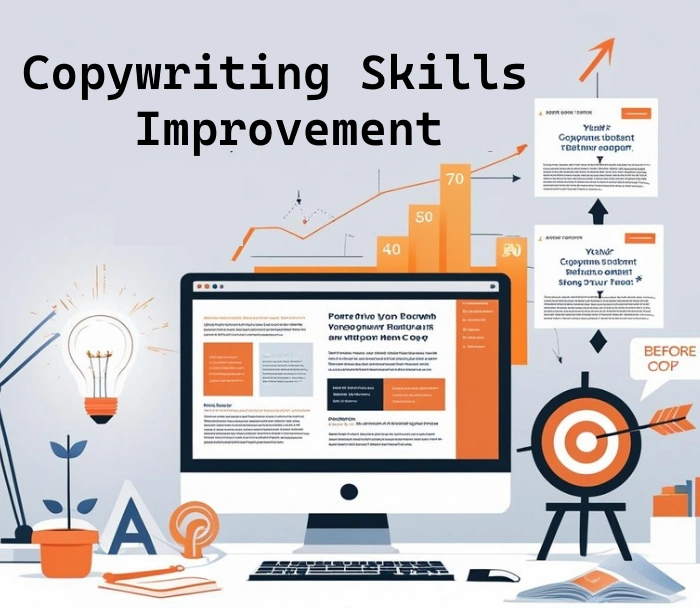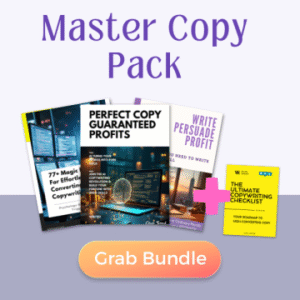You landed here because you’re tired of writing copy that falls flat. Good news: learning how to improve copywriting skills doesn’t require a master’s degree or mystical powers. I’ve been coaching copywriters for eight years, and I’m about to share the exact strategies that turn rookie marketers into conversion machines.
Let’s skip the fluff and get straight to what works.
Why Your Copy Probably Sucks (And How to Fix It)
Here’s the brutal truth: most beginner copy sounds like it was written by a committee of robots. You’re not alone in this struggle. When I started out, my headlines were so boring they could cure insomnia.
The problem isn’t your writing talent. It’s that you’re trying to sound “professional” instead of human. Remember your audience, appeal to their needs and wants, and talk to them in a natural, human way. Stop writing like you’re addressing a boardroom when you should be having a conversation with a friend.
Most entry-level marketers make three fatal mistakes:
- They write for everyone instead of someone specific
- They bury their main point in unnecessary words
- They forget that people buy emotionally, not logically
Fix these, and you’ll see immediate improvement.
Related articles:
- The Best Tips to Improve Copywriting for Beginners
- Books to Improve Copywriting Skills
- Best copywriting Exercises to Improve Writing
- All copywriting skills “From beginner to pro”
The 5-Minute Daily Practice That Changed Everything
Want to know the fastest way to improve your copywriting skills? Read like a detective, not a casual browser.
Every morning, I spend five minutes analyzing one piece of copy that caught my attention. Could be an email, an ad, or a landing page. I ask myself:
- What made me stop scrolling?
- What emotion did this trigger?
- What’s the one thing they want me to do?
This habit transformed my writing faster than any course ever did. You should start improving your copywriting skills by reading more blogs, articles and dissecting web page copy from a marketing perspective.
Try this tomorrow: Screenshot three ads from your Facebook feed. Analyze what makes them work (or fail). You’ll start noticing patterns that you can steal—I mean, adapt—for your own copy.
The AIDA Framework (But Make It Actually Useful)
Every copywriting guru talks about AIDA. Most explain it wrong. Here’s the version that actually converts:
Attention: Don’t just grab attention—grab the RIGHT attention. Your headline should speak directly to your reader’s current problem. Not “Revolutionary Marketing Solution!” but “Why Your Facebook Ads Are Bleeding Money.”
Interest: This isn’t about listing features. It’s about painting a picture of their life after they solve their problem. Show them the transformation.
Desire: Make them want it so badly they can taste it. Use specific details and social proof. “Sarah increased her conversion rate by 47% in three weeks using this exact strategy.”
Action: Tell them exactly what to do next. Not “Contact us for more information” but “Click here to grab your free template.”
I learned this the hard way after writing dozens of “clever” headlines that nobody clicked. Sometimes the obvious approach is obvious for a reason.
The Power of One: Why Trying to Appeal to Everyone Appeals to No One
Here’s a mistake I see constantly: writing for “business owners” or “marketers” instead of “Sarah, the 28-year-old marketing coordinator who’s stressed about her upcoming campaign review.”
Your copy gets powerful when you write for one specific person. I call this the “kitchen table test.” Would you say this to your ideal customer if they were sitting at your kitchen table? If not, rewrite it.
Create a detailed avatar:
- What’s their biggest frustration right now?
- What do they really want (not what they say they want)?
- What language do they use when describing their problems?
When you nail this, your copy will feel like mind-reading to your readers.
The 3-Second Rule That Kills Bad Copy
Your reader decides to keep reading or bounce in three seconds. That’s it. Your opening has to hook them immediately.
Weak opening: “In today’s competitive digital landscape, businesses are constantly seeking innovative solutions to optimize their marketing efforts.”
Strong opening: “Your last three Facebook ads bombed. Here’s why.”
The second one works because it’s specific, relatable, and promises a solution. It doesn’t waste time setting up context that nobody cares about.
Stop Writing Like a Textbook
Academic writing kills conversions. Your copy should sound like you’re explaining something to a friend who’s in a hurry.
Instead of: “Our comprehensive solution leverages cutting-edge technology to optimize your marketing ROI.”
Try: “We help you stop wasting money on ads that don’t work.”
See the difference? The second version uses simple words and focuses on the benefit, not the process.
The Emotional Trigger That Trumps Everything
Fear of missing out gets attention. Fear of continued pain gets action.
Don’t just tell people what they’ll gain. Show them what they’ll lose by not acting. What’s the cost of staying stuck?
If you’re selling a time-management course, don’t just promise more free time. Remind them of the weekends they’ll miss with their kids if they don’t get organized.
This isn’t manipulation—it’s motivation. You’re helping them see the real stakes.
The Simplest Trick to Sound More Persuasive
Want to sound more credible instantly? Be specific.
Instead of: “This strategy increased conversions dramatically.”
Try: “This strategy increased conversions by 23% in six weeks.”
Specific numbers feel more believable than vague promises. Even if you’re rounding, specific beats generic every time.
Headlines That Actually Get Clicked
Your headline is your first impression and your last chance. Most people will never read past it.
Here’s my formula for headlines that work:
- Start with a number or specific benefit
- Include your target audience
- Promise a quick win or solution
Examples:
- “5 Email Templates That Tripled My Response Rate”
- “The 10-Minute Daily Habit That Doubled My Productivity”
- “Why 90% of Facebook Ads Fail (And How to Be the 10%)”
Notice how each one is specific, benefit-focused, and promises valuable information? That’s not an accident.
The Secret to Writing Emails People Actually Open
Email copy is different from web copy. It’s more personal, more immediate, and more likely to be read on mobile.
Your subject line should create curiosity without being clickbait. “Quick question about your marketing” works better than “URGENT: Revolutionary Marketing Secret Inside!”
In the email body, write like you’re updating a friend. Use their name, reference previous conversations, and keep paragraphs short.
Social Proof That Actually Persuades
Customer testimonials are great. Customer stories are better. Instead of “This product is amazing! – John S.”
Try: “I was skeptical about spending $500 on a course, but the first strategy I implemented brought in $2,000 in new clients within two weeks. Worth every penny. – Sarah M., Marketing Consultant”
The story format is more believable and gives context that helps readers see themselves in similar situations.
The Biggest Copywriting Mistake (And How to Avoid It)
The biggest mistake isn’t poor grammar or weak headlines. It’s not understanding your customer’s journey.
Someone discovering your brand for the first time needs different copy than someone who’s been following you for months. Some of the most common persuasive copywriting mistakes: Misunderstanding the target audience. Forgetting to create an emotional connection with your copywriting.
Map out your customer’s journey:
- Awareness: They realize they have a problem
- Consideration: They’re looking for solutions
- Decision: They’re ready to buy
Each stage requires different messaging. Don’t pitch your premium service to someone who just discovered they have a problem.
Testing: The Only Way to Know What Works
Here’s something most copywriting courses won’t tell you: even experienced copywriters guess wrong half the time.
The solution? Test everything. Headlines, subject lines, calls-to-action, even button colors. What works for one audience might flop for another.
Start simple:
- Write two versions of your headline
- Send them to equal portions of your audience
- Track which one performs better
- Use the winner and test against a new challenger
Testing takes the guesswork out of copywriting and turns you into a data-driven marketer.
The 30-Second Edit That Improves Any Copy
Before publishing anything, read it out loud. If you stumble over words or run out of breath, your readers will struggle too.
Cut unnecessary words. Replace complicated phrases with simple ones. If a sentence runs longer than 20 words, split it.
This 30-second edit has saved me from publishing countless pieces of clunky copy.
Building Your Copywriting Toolkit
Every good copywriter needs these tools:
Headline Analyzer: CoSchedule’s tool gives you feedback on your headlines before you publish.
Grammarly: Catches grammar mistakes and suggests improvements.
Hemingway Editor: Highlights complex sentences and suggests simpler alternatives.
Swipe File: A collection of effective copy you’ve found. Screenshot ads, emails, and landing pages that caught your attention.
These tools won’t make you a great copywriter overnight, but they’ll help you avoid embarrassing mistakes and improve faster.
The Long Game: Building Your Copywriting Career
Learning how to improve copywriting skills is a marathon, not a sprint. In 2025, copywriting focuses on AI-assisted writing, conversational tone, and hyper-personalization. The field is evolving, but the fundamentals remain the same.
Focus on understanding people, not just techniques. The best copywriters are amateur psychologists who understand what motivates people to take action.
Read everything: marketing books, psychology studies, and copy from different industries. The more you understand human behavior, the better your copy becomes.
FAQ: Your Copywriting Questions Answered
Q: How long does it take to see improvement in my copywriting skills? A: If you practice daily, you’ll see improvement in two weeks. Significant results typically come within 30-60 days of consistent practice.
Q: Do I need to take a copywriting course to improve? A: Not necessarily. Reading great copy, analyzing what works, and practicing regularly can be just as effective as formal training.
Q: What’s the best way to practice copywriting without a client? A: Rewrite existing ads, emails, and landing pages. Practice on your own social media posts. Create spec work for brands you admire.
Q: How important is grammar in copywriting? A: Clean grammar is important, but connection matters more. Perfect grammar with no personality will always lose to engaging copy with minor errors.
Q: Should I specialize in one type of copywriting? A: Eventually, yes. But start by learning the basics across all formats. Specialization comes naturally as you discover what you enjoy most.
Q: How do I know if my copy is working? A: Track metrics: open rates for emails, click-through rates for ads, conversion rates for landing pages. Numbers don’t lie.
Q: What’s the difference between copywriting and content writing? A: Copywriting aims to persuade and drive action. Content writing aims to inform and educate. Both are valuable, but they serve different purposes.
Conclusion: Your Next Steps to Copywriting Success
Learning how to improve copywriting skills isn’t about memorizing formulas or following templates. It’s about understanding people and communicating in a way that moves them to action.
Start with the basics: know your audience, write conversationally, and focus on benefits over features. Practice daily, even if it’s just for five minutes. Test everything and let data guide your decisions.
The copywriting world needs more practitioners who understand that great copy is really just great communication. You’ve got this. Now go write something that matters.
Remember: every expert was once a beginner. The difference between those who succeed and those who give up is simple—the successful ones keep writing, keep learning, and keep improving.
Your journey to master copywriting skills starts with your next sentence. Make it count.

